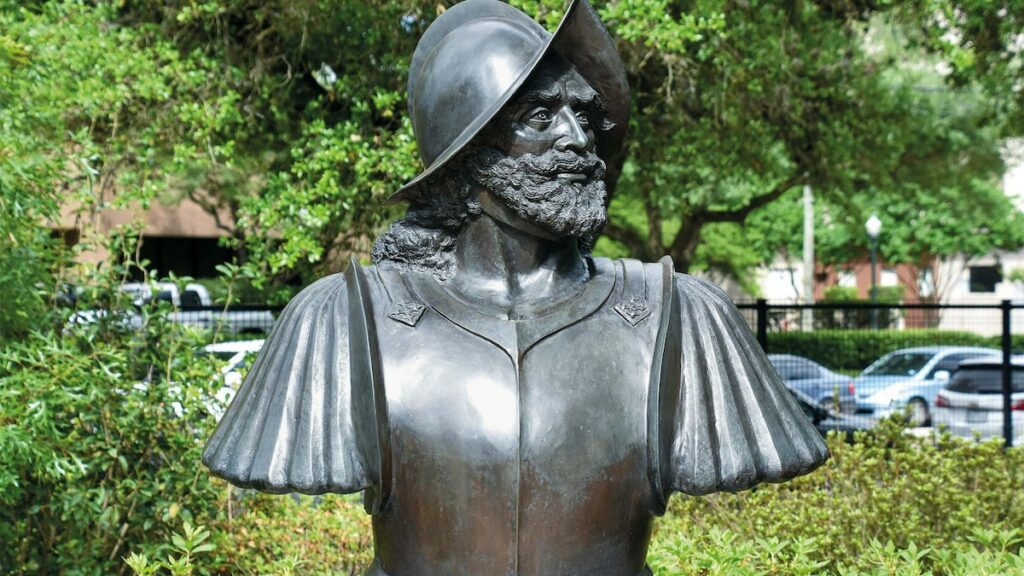For the following two years the quartet, led by Cabeza de Vaca, took a route that headed west across the Sierra Madre, and then down the Pacific coast of modern-day Mexico, in search of the viceroyalty of New Spain. In his Relación, Cabeza de Vaca names over 20 different Indigenous peoples that he encountered, including “the Avavares, with whom we stayed with for eight months.” The Avavares have since been identified as part of the hunter-gatherer Coahuiltecan culture that once inhabited southern Texas.
Having survived on a diet of roots, wild herbs, and fruits, the group had all radically changed in appearance since setting out from Spain. Their hair and beards were long; their near-naked bodies were covered in meager cloths and skins. “Like snakes we shed our hides twice a year,” Cabeza de Vaca later wrote, “and the sun and the air made us look as if we were naked … We received great pain because of the very heavy loads that we carried.”
In 1536 the travel-hardened group finally made contact with Europeans in northern Mexico. They were the first of many fascinated audiences Cabeza de Vaca and his companions would encounter. Later that summer they arrived in Mexico City and were hailed as celebrities. The following year, Cabeza de Vaca returned to Spain and wrote La Relación, chronicling his encounters during his near decade in North America. The book was published in 1542 to enormous acclaim.
(Guns, germs, and horses brought Cortés victory over the mighty Aztec empire.)
Documented travels
Not only is La Relación an exciting chronicle of Cabeza de Vaca’s survival in the American wilderness, it’s also a valuable record of the peoples living across the American south at that time. Cabeza de Vaca documented more than 20 different Indigenous cultures and recorded in great detail their clothes, rituals, homes, customs, and cuisines.
Cabeza de Vaca, shown a Spanish postage stamp, later revised his memoir to describe his turbulent governorship in Paraguay.
Granger/ACI
Few other contemporary accounts of the Americas in this period expressed such sympathy and deep knowledge of Indigenous peoples. Cabeza de Vaca sometimes mocked certain practices as superstitious, but the details of his overall documentation were respectful. He praised the technical abilities he saw, writing, “All the Indians from Florida we encountered were great archers … They shot their arrows with such force and precision.” He later documented the unique mourning process for children: “Of all the people in the world, they most love their children and treat them best.” Bereaved parents, he wrote, cried “thrice a day, before dawn, at noon and at dusk, followed by the whole tribe, day after day and for an entire year.”
The book reveals that Cabeza de Vaca’s first encounter with the Spaniards near Culiacán, in modern Mexico’s northwest, was not quite a joyous reunion. The Spaniards were engaged in capturing and enslaving Indigenous people. Angered at their actions, Cabeza de Vaca secured promises from his compatriots that the Indigenous people accompanying him would not be mistreated or enslaved.
After we dispatched the Indians in peace, and with thanks for what they had gone through with and for us, the Christians sent us to a certain Alcalde Cerebros. He took us through uninhabited country to prevent our communicating with Indians … So we went on with the idea of insuring the Liberty of the Indians, and when we believed it to be assured, the opposite took place: the Spaniards had planned to fall upon the Indians … and that plan they carried out.
Back to the Americas
Alongside the writings of Cabeza de Vaca, an 18th-century codex included this illustration of Guarani from Paraguay. Of the people, he wrote: “The Spaniardsarrived at a mighty river called Igatu … on its shore is a village of Guarani, who plant their corn and cacabi … And they came out to welcome the Spaniards and told them of the good treatment they were given.”
Album/Photo12/Archives Snark
After some time back in Spain, Cabeza de Vaca felt the pull of the Americas and longed to return. Despite the success of La Relación, he failed to be appointed governor of Florida. The Spanish king and Holy Roman emperor, Charles V, gave the job to conquistador Hernando de Soto instead.
Source link : http://www.bing.com/news/apiclick.aspx?ref=FexRss&aid=&tid=66b4b39bfc3d4c59bff87122a6cfbf69&url=https%3A%2F%2Fwww.nationalgeographic.com%2Fhistory%2Farticle%2Fcabeza-de-vaca-conquistador-shipwreck-texas&c=16203709755419231164&mkt=en-us
Author :
Publish date : 2024-08-07 23:59:00
Copyright for syndicated content belongs to the linked Source.
